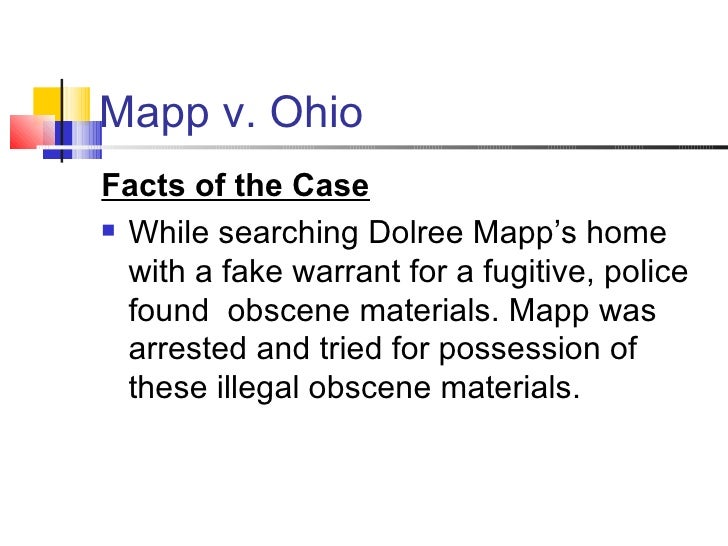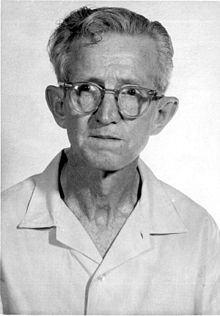What did the Supreme Court rule in Mapp v. Ohio?
Ohio reached the Court in 1961, it was not initially seen as a Fourth Amendment case. Dollree Mapp was convicted under Ohio law for possessing “lewd, lascivious, or obscene material.” Mapp appealed her conviction. She based her claim on First Amendment grounds, saying that she had a right to possess the materials. When the case reached the Supreme Court, however, the …
What is the constitutional issue in Mapp v Ohio?
He felt that Mapp v. Ohio was a case about a fundamental right to privacy, not about the constitutional protections against searches and seizures. Safeguarding the right to privacy did not require federal rules of evidence to be imposed on the states.
What was the ruling in Mapp vs. Ohio?
MAPP V. OHIO, decided on 20 June 1961, was a landmark court case originating in Cleveland, in which the U.S. Supreme Court ruled that under the 4th and 14th Constitutional amendments, illegally seized evidence could not be used in a state criminal trial. This decision significantly changed state law-enforcement procedures throughout the country. The case began on 23 May …
What is a summary of Mapp v Ohio?
Mar 11, 2017 · March 11, 2017 by: Content Team. Following is the case brief for Mapp v. Ohio, United States Supreme Court, (1961) Case Summary of Mapp v. Ohio: Mapp’s home was searched absent a warrant. The search yielded the discovery of material classified as “obscene” under Ohio state law. The Supreme Court held that evidence obtained from an ...

What rights did the Mapp v Ohio Supreme Court decision protect?
What rights are protected under the 4th Amendment?
What Amendment was violated in Mapp vs Ohio?
Clark, the majority brushed aside First Amendment issues and declared that all evidence obtained by searches and seizures in violation of the Fourth Amendment is inadmissible in a state court.
What was the dissenting opinion in Mapp v Ohio?
What is the 8th amendment do?
What is Fifth Amendment right?
Who won the Mapp v Ohio case?
What impact did Mapp vs Ohio have on our criminal justice system?
What was the outcome of the Engel v Vitale case?
What did the Supreme Court decide in Mapp v. Ohio Why is this case so important to how law enforcement must operate?
Do you agree with the Court's decision in the MAPP case quizlet?
What is Mapp v. Ohio?
Ohio was a 1961 landmark Supreme Court case decided 6–3 by the Warren Court, in which it was held that Fourth Amendment’s protection against unreasonable searches and seizures applied to the states and excluded unconstitutionally obtained evidence from use in state criminal prosecutions. This decision overruled Wolf v.
What was the Supreme Court case in Mapp v. Ohio?
Ohio (1961) Mapp v. Ohio was a 1961 landmark Supreme Court case decided 6–3 by the Warren Court, in which it was held that Fourth Amendment’s protection against unreasonable searches and seizures applied to the states and excluded unconstitutionally obtained evidence from use in state criminal prosecutions. This decision overruled Wolf v.
What was Dollree Mapp convicted of?
Dollree Mapp was convicted under Ohio law for possessing “lewd, lascivious, or obscene material.”. Mapp appealed her conviction. She based her claim on First Amendment grounds, saying that she had a right to possess the materials.
What is the 4th amendment?
The Fourth Amendment protects individuals from unreasonable searches and seizures and requires two branches of government to agree in order for search warrants to be issued. But what happens when the police do not act within the law, and conduct searches without a warrant? The Fourth Amendment does not specify.
Which amendment is Mapp v. Ohio?
Mapp v. Ohio extended the exclusionary rule, which was then being applied to the federal courts, to the state courts. Application of the Fourth Amendment protection against the introduction of evidence obtained from an illegal search and seizure is applied to the states through the 14 th Amendment.
What court did Mapp appeal to?
Mapp appealed the conviction to the Ohio Supreme Court, which sustained the conviction although it acknowledged a reasonable reversal argument since the evidence was obtained in an improper manner. Mapp then appealed to the United States Supreme Court stating the conviction was the result of unreasonable search and seizure.
What happened to Mapp in Ohio?
Mapp took the warrant and police responded by physically retrieving it from her. As a result of the search, books and photos belonging to Mapp were introduced into evidence. Mapp was convicted for possessing lewd and obscene material under Ohio law despite the fact no evidence was offered to show that police obtained a warrant to search her home.
Which amendment does not specifically mandate the exclusion of illegally seized evidence?
Black states the Fourth Amendment does not specifically mandate exclusion of illegally seized evidence. However, when combined with the Fifth Amendment (right against incrimination) a constitutional right emerges requiring the exclusion of illegally seized evidence in criminal trials.
Did the police find Dollree Mapp?
She demanded to see their search warrant, and they waved a piece of paper at her, claiming it was a warrant. It was not . Police did not find the suspect they were looking for. They did, however, find sexually explicit books and photographs. Mapp was charged with violating Ohio state law prohibiting “lewd, lascivious, or obscene material.” She was convicted and sentenced to one to seven years in prison.
What is the exclusionary rule?
The exclusionary rule holds that evidence seized in violation of the Fourth Amendment may not be used against the accused at trial. Some students will say that this rule is the essence of justice.
What is the 4th Amendment?
The rule that evidence seized in violation of the Fourth Amendment may not be used at trial , which many Americans are familiar with from television crime shows, has its origins in the landmark Supreme Court case Mapp v. Ohio (1961). In this case, the Court held that states must abide by the “exclusionary rule” – a sometimes-controversial means of ensuring justice.
What is the essence of justice?
Some students will say that this rule is the essence of justice. It ensures checks and balances in government before someone’s home and papers can be searched by forcing the police—agents of the executive branch—to get a warrant from a court—the judicial branch—in order to perform a search.
What is Mapp v. Ohio?
Ohio, Illegal Searches. Mapp v. Ohio, Illegal Searches. Before 1961, the rule that illegally obtained evidence is excluded at trial applied only to federal law enforcement agencies. This was referred to as the federal exclusionary rule and was based on the U.S. Constitution’s 4th Amendment prohibition against illegal searches ...
Who wrote the plurality opinion?
The Justices Analyzed the issues in Different Ways. The plurality opinion was written by Justice Tom C. Clark on behalf of himself and two other justices. There were three concurring opinions to make the majority vote. Mapp’s attorneys argued that the Ohio pornography laws infringed on her freedom of speech.
Where did Dollree Mapp live?
Dollree Mapp lived alone with her fifteen-year old daughter in an apartment on the second floor of a Cleveland, Ohio duplex. On May 23, 1957, at approximately 1:30 p.m., three police officers arrived at her house and requested admittance to Mapp’s apartment.
What is the rule of Weeks v. United States?
383, excluding in federal criminal trials the use of evidence obtained in violation of the Fourth Amendment, derives not from the "supervisory power" of this Court over the federal judicial system, but from Constitutional requirement. This is so because no one, I suppose, would suggest that this Court possesses any general supervisory power over the state courts. Although I entertain considerable doubt as to the soundness of this foundational proposition of the majority, cf. Wolf v. Colorado, 338 U. S., at 39-40 (concurring opinion), I shall assume, for present purposes, that the Weeks rule "is of constitutional origin."
Is the Fourth Amendment enforceable against the Federal Government?
Since the Fourth Amendment's right of privacy has been declared enforceable against the States through the Due Process Clause of the Fourteenth, it is enforceable against them by the same sanction of exclusion as is used against the Federal Government. Were it otherwise, then just as without the Weeks rule the assurance against unreasonable federal searches and seizures would be "a form of words," valueless and undeserving of mention in a perpetual charter of inestimable human liberties, so too, without that rule the freedom from state invasions of privacy would be so ephemeral and so neatly severed from its conceptual nexus with the freedom from all brutish means of coercing evidence as not to merit this Court's high regard as a freedom "implicit in the concept of ordered liberty." At the time that the Court held in Wolf that the Amendment was applicable to the States through the Due Process Clause, the cases of this Court, as we have seen, had steadfastly held that as to federal officers the Fourth Amendment included the exclusion of the evidence seized in violation of its provisions. Even Wolf "stoutly adhered" to that proposition. The right to privacy, when conceded operatively enforceable against the States, was not susceptible of destruction by avulsion of the sanction upon which its protection and enjoyment had always been deemed dependent under the Boyd, Weeks and Silverthorne cases. Therefore, in extending the substantive protections of due process to all constitutionally unreasonable searches—state or federal—it was
When did Boyd v. United States take place?
Seventy-five years ago, in Boyd v. United States, 116 U.S. 616, 630 (1886), considering the Fourth 4 and Fifth Amendments as running "almost into each other" 5 on the facts before it, this Court held that the doctrines of those Amendments

Popular Posts:
- 1. how to settle non fault accident without attorney
- 2. who pays attorney fees and court costs in divorce over money
- 3. when can you use a durable power of attorney for a real estate purchase agreement arizona
- 4. how much does ny city attorney make
- 5. why do i need a startup attorney
- 6. who are all the state attorney general's
- 7. where in colorado can i get a pro bono attorney for an appeal for a divorce
- 8. if a district attorney is unreachable who you talk to next in legal action
- 9. how to find a learning disability attorney
- 10. what was attorney general palmer fighting against